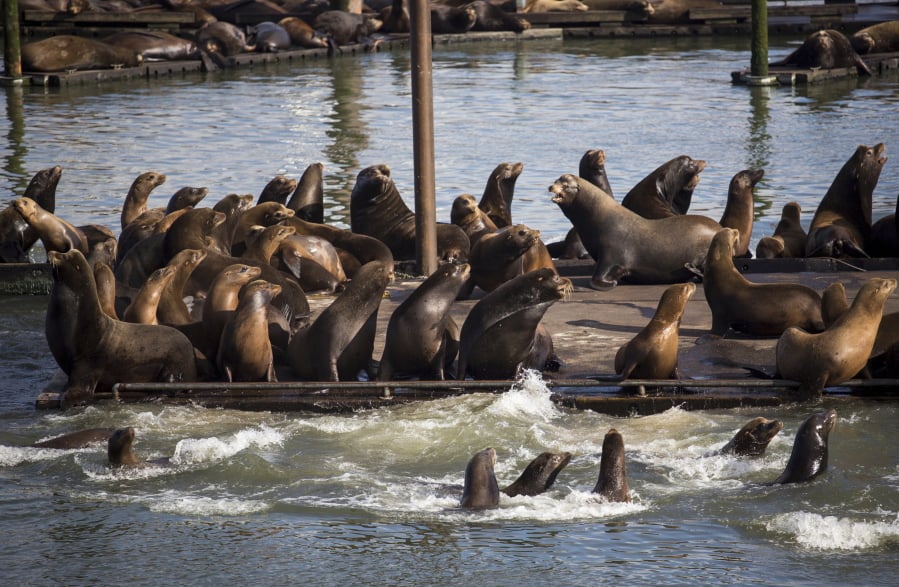A big rebound in the sea lion population along the West Coast in recent years has created a constant battle to wrangle the protected animals. They’re smart and fun to watch from a safe distance, but also noisy, smelly and proving to be a headache for some coastal marinas.
“It’s a free zoo kind of, just don’t pet ’em!” observed Dennis Craig of Olympia while he watched a pier at Washington’s Westport marina nearly sink under the weight of dozens of burly bulls jostling and snoozing in the sun.
“You notice when the charters come in, they’ll swing wide just so people can get a closer look because, like I say, it’s entertaining,” Craig said.
The flip side of these flippered fish fiends can be seen in the mounting bill to the marina, including the cost of busted docks, broken electric stanchions and lost business.
“Nearly all of our net revenue was used to repair damage caused by sea lions this year, taking those funds away from infrastructure improvements and replacements that are critical to the marina facility and our users,” Westport Marina business manager Molly Bold said in an email.
Sea lions have blocked people from mooring their boats. In other cases, commercial fishermen have had to run through a sea lion gauntlet just to get onto their vessels. The sea lions even snatched a few pet dogs right off the piers, said Westport Aquarium co-owner Marc Myrsell, who volunteers to monitor the marine mammals.
Myrsell has counted up to 200 or 300 sea lions on the docks at a time.
“If a person is walking down the dock and they have a bag in their hand, that sea lion in its mind might think that person has food and can get aggressive because some people have been feeding them — intentionally or unintentionally,” Myrsell said.
The most recent population estimate for California sea lions along the West Coast is around 257,000. Robert Anderson, the marine mammal program manager at the NOAA Fisheries regional office in Portland, pegged the population growth rate at roughly 5 percent per year, although the sea lions may soon reach the carrying capacity of their marine environment.
Deterrents
The current abundance of sea lions is at least seven times greater than the population recorded in the late 1960s. Before Congress passed the Marine Mammal Protection Act in 1972, fishermen and the public could take matters into their own hands and shoot pesky sea lions. In earlier decades, the beasts were also killed for hides or to make pet food.
Now, the proliferation of sea lions has created issues from Neah Bay to Brookings, Ore. — occasionally in Puget Sound too.
And Westport is not even the worst off. Astoria, Ore., attracts the most sea lions by far, according to interviews with port staff and the National Oceanic and Atmospheric Administration.
The Port of Astoria once famously deployed a fiberglass fake orca to scare the sea lions. The replica soon capsized, nearly drowning its operator. Astoria also tried out tube-shaped inflatable air dancers, beach balls, flashing lights as well as low railings with various plastic attachments.
“Nothing works for long or it costs too much,” Port of Astoria executive director Jim Knight said in an interview Thursday.
He said the local sea lion census peaked at around 3,000 critters two years ago and is lower right now. The floating port docks offer a convenient resting place for California and Steller sea lions alike between hunts for fish migrating up the Columbia River.
The low rail on the finger piers in foreground worked for a while to deter sea lions at the Port of Astoria’s East Mooring Basin, but not anymore.
Knight said the most effective deterrent was a low-voltage electrified mat deployed on a demonstration basis by Vancouver-based manufacturer Smith-Root at both Astoria and Westport.
“It actually did work,” Knight said. “But the cost of them was way more than the port could afford.”
The problems in marinas continue because sea lions are smart and will habituate to most deterrence strategies, NOAA’s Anderson said.
“You’ve got to be pretty persistent about it,” Anderson said in an interview. “Once you apply whatever deterrence method you do, if you walk away they’re going to come right back.”



